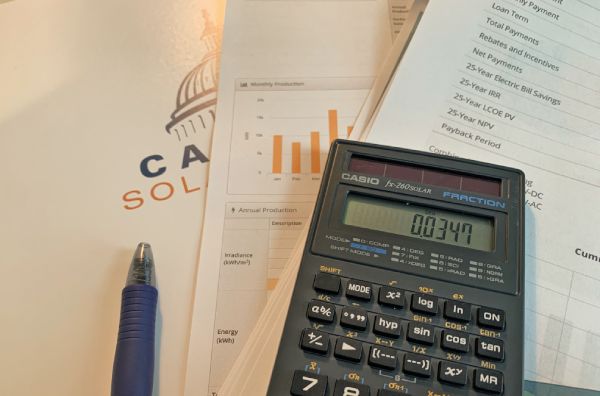Written by CSG Staff | Published on June 9th, 2021
What is Levelized Cost of Energy (LCOE)?
Levelized Cost of Energy or LCOE is a commonly used term utilized by solar energy companies to determine the cost of power produced by solar units over a predicted period of time. This period of time is typically defined by the warranted life of the solar PV system. Simply put, LCOE is the measure of the cost of power created by a solar PV system. It is necessary to define a system’s LCOE as purchasing a solar PV system is essentially adding a layer of safety against rising utility costs by fixing your per-kWh rate at a known and established price.
When evaluating a potential solar project, your contractor will utilize LCOE to determine the efficiency and viability of the solar panel system needed and create a project portfolio that will be presented and overviewed by your solar consultant.

How is LCOE determined?
The process of calculating LCOE will vary depending on project and site specific inputs. Below is an example of a typical solar PV system. (Note: these figures will likely differ from your system and are only meant to demonstrate how LCOEs are defined).
1. First, we determine your Net System Cost:
Total System Cost – Total Financial Incentives = Net System Cost
(Tax benefits will vary widely depending on a variety of factors. See our page on incentives for more information on the possible benefits for your company. Your net system cost would include additional ongoing charges such as financing, cost of capital, operations & maintenance, and insurance expenses).
2. Next, your contractor will determine the Total kWh Production over an established period of time (this is usually the warranty period of the system). Generally, a system is warranted for 25 years:
Total kWh Production in a Year * 25 Years = Total kWh Produced
3. Last, LCOE is determined by using the two figures above. Divide the Net System Cost by the Total kWh Produced over 25 years:
Net System Cost / Total kWh Produced = LCOE per kWh
More often than not, LCOE per kWh rates are substantially less than the average commercial utility rates in the designated project area. For example, commercial electricity rates in Maryland average 10.43 cents per kWh, whereas LCOE rates often come in at around 5-7 cents per kWh.
Why Solar Reduces Your Energy Bills
Solar can bring the average cost of energy per kWh down by 50% or more depending on where your solar project is developed. The LCOE of a 25-year solar asset comes out to be roughly anywhere from 5-7 cents per kWh over the 25 year lifetime of the solar asset.
In a Cash Purchase scenario, this boils down to a simple contract that consists of paying for 25 years of energy upfront (the solar PV system itself) in exchange for an average energy rate that is guaranteed to be 30-50% lower than what the client is paying now for electricity.
Note: This model does not hold true if financing models are used such as pulling a loan with a certified green project lender, CPACE, Personal Financier (more parties involved = lower overall ROI).
If your business is interested in learning more about solar PV and the importance of LCOE in determining how much you can save on utility costs, contact our solar consultants at Capital Solar Group to learn more.

